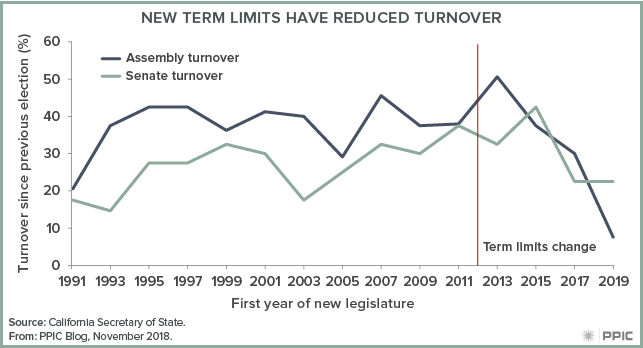California Democrats are on track to add two seats to their majorities in both the state assembly and the state senate. Combined with Democrat Gavin Newsom’s win in the governor’s race, these flips give Democrats the supermajorities they need for unfettered pursuit of their legislative agenda. While this partisan shift is certainly important, the impact of a recent change in term limits tells a larger story of remarkable stability.
In 2012, California voters passed Proposition 28, which relaxed term limits by allowing legislators to serve up to 12 years in either or both chambers of the legislature. Under the previous rules, term limits for each chamber required anyone who wanted to spend the maximum 14 years in the legislature to move from one chamber to the other. And because the senate has half as many seats as the assembly, no more than half could serve the full 14 years.
Proposition 28 applies to legislators who were elected for the first time in 2012 or later. Most of these legislators have been sticking with the seats they originally won, where incumbency makes reelection most certain.
There has been a gradual adjustment to the new limits as the last few legislators covered by the old regime move through the system. Most of these members started in the assembly and moved to the senate, and their assembly seats were filled by legislators subject to the new limits. By 2018, only one assembly incumbent was covered under the old regime, down from 14 in 2016 and 37 in 2014. This incumbent, Anna Marie Caballero, was termed out and ran for the senate.
The impact of Proposition 28 has been significant, particularly in the assembly, where turnover has plummeted from a peak of 50% in the 2012 election to just 8% this cycle—a 30-year low. Senate terms are twice as long as assembly terms and only half of the chamber is up for reelection each cycle, so there is naturally less turnover there. Nonetheless, turnover in the senate shows signs of decline.

Proposition 28 has also led to a gradual increase in assembly expertise. The average member of the assembly next year will have spent almost five years in the legislature, longer than in any legislative term since the original term limits first began to force members out. Senate expertise, on the other hand, has declined from 18 years in 1995 to just 6.5 after the 2018 election, and may never increase much again. Under the old regime, most senators served a full 14 years by moving over from the assembly; though more will now spend their whole career in the senate, they can serve 12 years at most.
The growth in assembly expertise helps bring the two chambers closer to equality in the policymaking process. But this expertise necessarily comes at the price of lower turnover in some elections. Partisan changes may rightly receive most of the attention this election cycle, but broader changes in membership are the exception not the rule.




